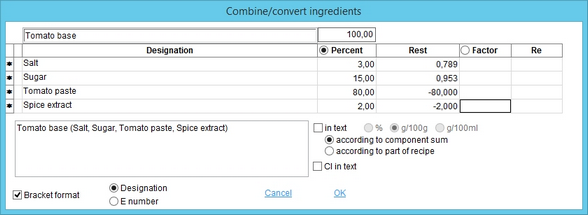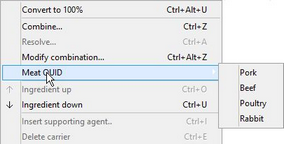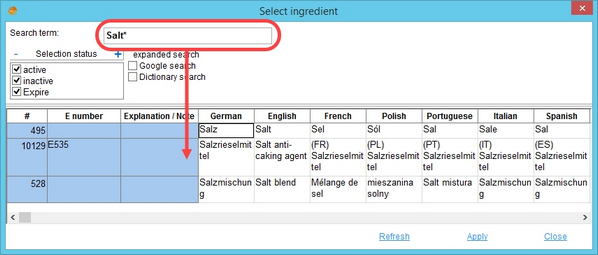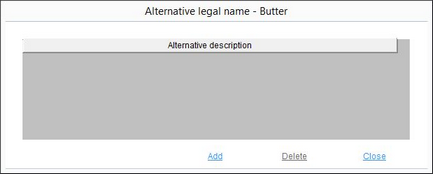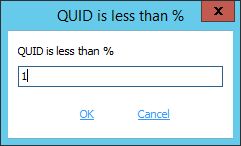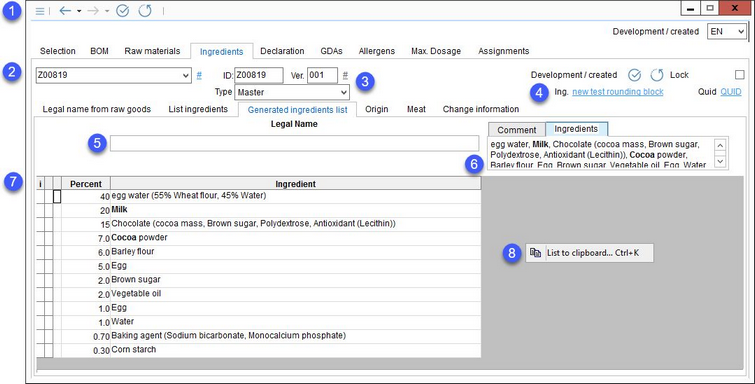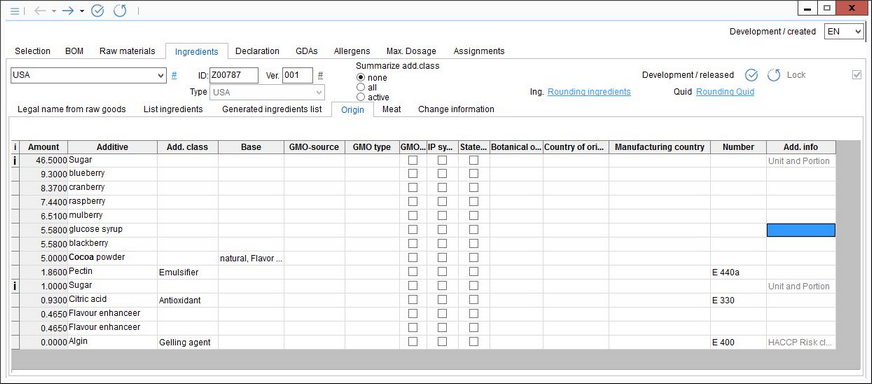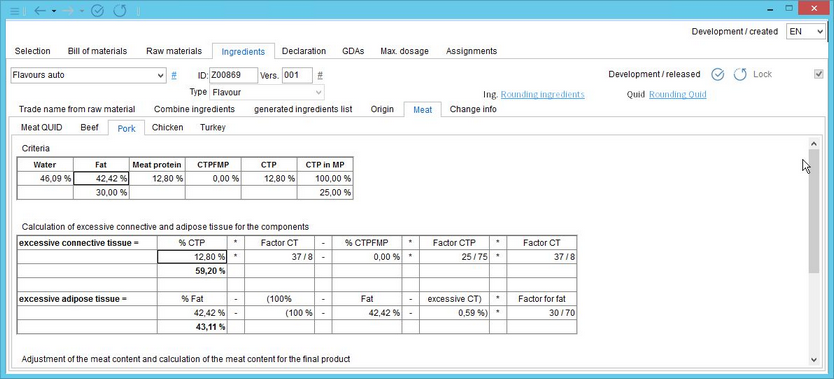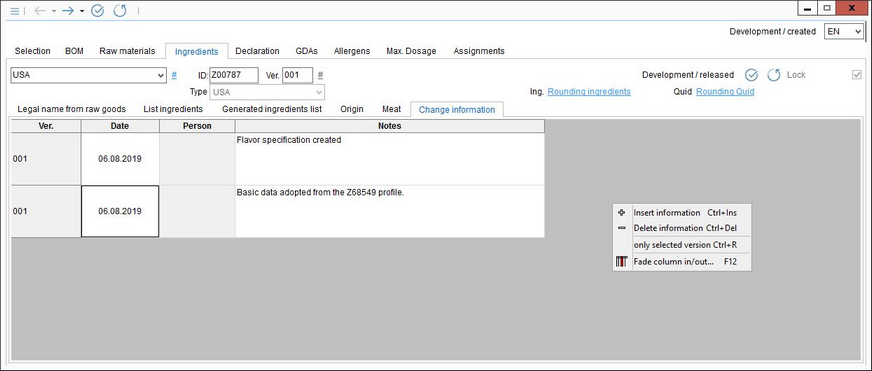Recipes are created by using raw materials (Master data objects) which consist of ingredients (trade names). The tab Ingredients represents the main section for building ingredients lists. It contains the following sub-tabs:
•Origin.
•Meat.
Trade Name from Raw Goods
In the Trade name from raw material sub-tab, a new ingredient list can be created. Additionally, by using Declaration automatic, an automatically generated ingredient list may be selected in this dialog.
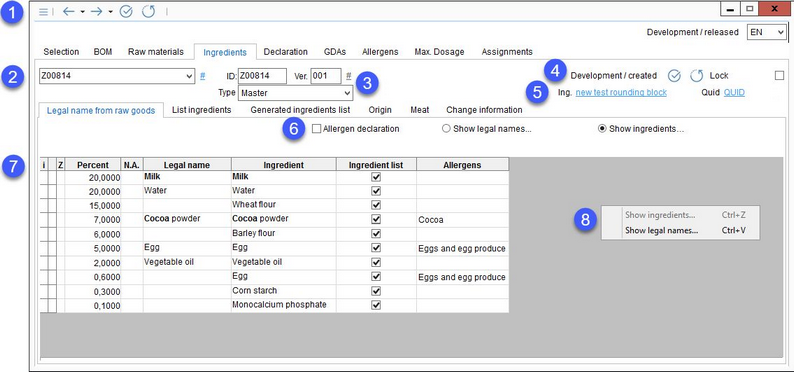
1.Quick access toolbar: For more information, see Declaration/Function & Processes/Basic Declaration Functions.
2.List of ingredients: Select an existing ingredient list or press # to create a new list. See Declaration/Functions & Processes/Create a list according to declaration and Declaration/Functions & Processes/Create a list according to flavor specification for more information for more information.
Right-click on the # button to delete the ingredient list or its currently loaded version.

3.ID: The identification number of the ingredients list. It is generated automatically.
Ver.: The release version. An ingredients list can be controlled via processing and control statuses. When the control status of the list is Released, it is not possible to edit the list anymore, but a new release version can be created using the # button, located next to the version number.
Type: The type of the ingredients list which can be set up via Administration/General/Declaration - automatic. Types are used as identifiers and are directly associated with a declaration profile (2). Type is important for Reporting and Assignments.
4.Processing/control status of the ingredient list. This section is shared across all of the sub-tabs of the Ingredients tab.
|
Control dialog |
|
History of changes |
5.Rounding: These two buttons are used for selecting rounding blocks for rounding of ingredient quantities and QUID values. After selecting one of the predefined rounding blocks, the button's name changes to the name of the selected block. For more information about rounding blocks, please see Administration/General/Rounding Blocks. To remove (deactivate) the blocks, right-click on the block you want to remove and select Remove rounding.
6.Allergen declaration: Allergens defined in Administration/Trade names will be included in the list.
Show legal names/Show ingredients: Switch between the view of the legal names (highest level) and the ingredients (lowest level).
7.i: If a letter i is present in the first column, it indicates that there is a trade name description available for the ingredient. Click and hold your mouse pointer on the letter to display this information. A description of an ingredient can be added via Administration/General/Trade Definition → field Explanation / Note.
Z: Grouping. In Master data/Ingredients, it is possible to give a Master data object a trade name. If you select the option Show legal names (6), only the trade name of the Master data object will be displayed, although it contains multiple ingredients. Column Z will contain symbol > and the name will be present in the column Legal name.
Percent: The proportion of each ingredient in the recipe.
N.A.: Indicates whether the quantity of the ingredient in the material equals N.A. in order to depict that the amount is undefined and not precisely 0. The Percent column displays the N.A. values, such as 0, therefore, the N.A. column is used for differentiation purposes.
Legal name: The legal name of the ingredient.
Ingredient: The name of the ingredient.
Ingredient list: Select this checkbox to include the ingredient in the ingredient list.
Allergens: Allergens contained in each ingredient. Allergens can be assigned to ingredients via Administration/General/Trade Definition → field Allergen description.
8.You can switch between the two options described in point 6 using the right-click context menu.
List ingredients
In this dialog, you can use various functions to further customize the ingredient list created in the Trade name from raw material tab. This includes adding or removing ingredients, combining more ingredients under one trade name, etc. This dialog is arranged in the same way as the dialog Master data/Ingredients.
1.Quick access toolbar: For more information, see Declaration/Function & Processes/Basic Declaration Functions.
2.Ingredients list: Select one of the existing ingredients lists, either created automatically, using the declaration automatic, or manually.
3.Identification details: The identification number, release version, and type of the list.
4.Rounding: These two buttons are used for selecting rounding blocks for rounding of ingredient quantities and QUID values. After selecting one of the predefined rounding blocks, the button's name changes to the name of the selected block. For more information about rounding blocks, please see Administration/General/Rounding Blocks. To remove (deactivate) the blocks, right-click on the block you want to remove and select Remove rounding.
5.i: The letter i present in this column indicates that there is a trade name description available for the ingredient. Click and hold your mouse pointer on the letter to display this information. A description of an ingredient can be added via Administration/General/Trade Definition → field Explanation / Note.
Z*: Select ingredients for combining (right-click option Combine).
Z: Grouping. Ingredients combined together are marked with symbol >.
U: Converted ingredients.
Del.: Exclude the ingredient from the ingredients list without deleting it completely.
Q out: If activated, the QUID out information will be used next to the ingredient in the ingredient list. The ingredient will be ignored when converting to 100% (see below).
Q in: If activated, the QUID in information will be used next to the ingredient in the ingredient list. The ingredient will be ignored when converting to 100% (see below).
QUID%-out: QUID (Quantitative Ingredients Declaration) based on the output quantity (quantity including loses). This field is manually editable. If the Q out checkbox (3) is selected, the percentage will be included in the ingredients list.
% out: The original value of QUID-out%.
QUID%-In: QUID based on the input quantity (= quantity without loses). Can be manually edited. If the Q in the checkbox (3) is selected, the percentage will be included in the ingredient list.
% in: The original value of QUID-in%.
Ingredient: The name of the ingredient.
Dry Matter: The DM carrier. Carriers can be assigned to an ingredient via Administration/General/Trade Definition → field Carrier designation.
Trade name: The trade name of the Master data object. See point 7 of the previous section Trade name from raw material for more information.
Allergens: The allergens contained in each ingredient. Allergens can be assigned to ingredients via Administration/General/Trade Definition → field Allergen description.
Class: Additive class can be assigned to ingredients via Administration/General/Trade Definition → field Classification.
A: The flavor components. These may include natural and artificial extracts and substances.
S: Other components. Flavoring products may contain other components, such as ethanol.
WONF: With Other Natural Flavorings. These are composed of the named source but also contain other natural flavorings.
FTNF: From the Named Fruit. Fruit flavor extracts derived exclusively from a specific fruit.
FTNS: From The Named Source. The sole source of the flavor is a material other than fruit.
FINJ: From The Named Juice. Fruit flavor extracts derived exclusively from a juice of a specific fruit.
Additive: Indicates an assignment of an additive class in Administration/General/Trade Definition.
Proc. steps: Processing steps information originating from selection list PDM internal → Processing step (code PR_STEP).
QUID-min %: When selected, the QUID value receives additional text that can be defined via Administration/Texts → Text area Declaration (DEKL) → Text type Text templates (VTEXT) → QUID_ATLEAST_TEMPLATE. Using this predefined text you can create phrases like Contains at least 75% of beef where 75% is the QUID value.
Footer: An additional selection list of information that will be displayed as a footnote of the ingredient list (running text). The ingredient will receive a superscript number referencing the footnote.
In text: This field contains a selection list that is used to select additional information (e.g. contents of fields Base, Country of origin, etc.) to be included in the ingredients list (running text). The precondition for this feature is that the selection list options are assigned to the ingredient in Administration/General/Trade Definition → section Comment. Without this, the field will not contain any selection list. Once you select the type of information to be declared, you may need to press the Refresh button. The information will then display in the list of Ingredients.
6.Right-click context menu. The following options are accessible:
Convert to 100%: If the total percentage of % out is not 100%, SpecPDM will change the quantities of all ingredients to reach it. When the QUID in or QUID out checkboxes are selected, SpecPDM ignores these quantities and adjusts the other quantities to reach the 100%.
|
Example: There are two ingredients in the recipe: Water (20%) and Milk (40%). So the current total is 60%. •When no QUID in or QUID out checkbox is selected, converting to 100% will result in Water (33,3%) and Milk (66,6%). •When we select checkbox QUID in or out for Water, the result will be Water (20%) and Milk (80%). •When we select checkbox QUID in or out for both ingredients, the result will be Water (20%) and Milk (40%) because both quantities are locked so converting to 100% is not possible. |
Combine: Combine ingredients marked with * in the second column into one. See Master data/Ingredients for more information about manual combining of ingredients and a description of the Combine/convert window.
Resolve: Resolve combined ingredients into separate ingredients.
Modify combination: Available for combined ingredients only. Opens the Combine/convert ingredients dialog where the quantities of the combined ingredients as well as the declaration options can be adjusted.
Meat QUID: Some products may contain meats from multiple types of animals. When declaring the constitution of the meat used in the product (i.e. the QUID of adipose tissue, connective tissue and meat) it is necessary to declare it for each animal separately. Use the selector in column Z (see point 1) to select ingredients to be included for the meat QUID declaration for each animal, then select the corresponding meat QUID type from the right-click context menu.
The selected components will be replaced with the calculated meat QUID for the three constituents of the meat. You can define the three trade names that will replace the original ingredient names via Administration/General/Declaration - automatic → section Meat (e.g. the trade name of the connective tissue for chicken is chicken collagen).
|
Ingredient up: Move the ingredient one place up the list. |
|
Ingredient down: Move the ingredient one place down the list. |
|
Insert supporting agent: A carrier can be inserted to the list using this option, provided a carrier has been associated with the ingredient via Administration/General/Trade Definition → field Carrier designation. |
|
Delete carriers: Delete the inserted carrier. |
|
Show root conversion: If you modify the quantities of ingredients that make up a combined ingredient using the Modify sum option, you can use this option to see the original quantities. |
|
Add ingredient: Add an additional ingredient using the Select ingredient dialog. Enter the ingredient's exact name or partial name with the wild-card character * and click Refresh. Double-click on an ingredient from the list of results to add it to your list. |
|
Alternative legal name: Use a predefined alternative name for the selected ingredient (Administration/General/Trade Definition → field Alternative trade definition). You can also create a new one by clicking on Insert. A standard trade name definition dialog appears where you can create a new trade name which will be added to the list of alternative trade names for the selected ingredient. |
|
Summarize all like materials: Two or more identical ingredients can be added to the list. This option summarizes all into one. |
|
List all like materials selected: Two or more identical ingredients can be added to the list. This option summarizes those marked with * in the second column into one. |
|
Summarize ingredients of selected recipe: Ingredients used in the list can come either from a recipe or can be added additionally in the Declaration module. This option combines all ingredients that originate in a recipe into one. |
|
Summarize additive classes: Summarizes all ingredients that belong to the same additive class (column Class). |
|
Group classes according to: Group ingredients belonging to the same additive classes according to the declaration settings linked to a particular declaration type. |
|
Group selected classes according to: Group only the ingredients belonging to the same additive classes that are marked with * in the second column. |
|
Contains less than X%: This option is used to include the sentence Contains ... % or less of together with a selected trade name in the ingredients list. Right-click on the ingredient you want to use (e.g. salt), then select this option and specify the QUID percentage (e.g. 1%). The ingredients list will then contain sentence Contains 1% or less of salt. The ingredient will become highlighted. You can see the result in the tab Generated ingredients list.
|
|
Tolerance and data source: Define the tolerance range for the selected percentage. Please see the article Declaration/Functions & Processes/Using tolerance range for more information. |
|
Fade column in/out: To show or hide columns. It is also possible to rename columns by double-clicking on their name. |
Generated Ingredients List
The finalized list of ingredients, created in tab Combine ingredients, is displayed in this tab. Here, you can adjust details in the list and save it as a new trade name.
1.Quick access toolbar: For more information, see Declaration/Function & Processes/Basic Declaration Functions.
2.Ingredients list: Select one of the existing ingredient lists, either created automatically, using the declaration automatic, or manually.
3.Identification details: The identification number, release version, and type of the list.
4.Rounding: These two buttons are used for selecting rounding blocks for rounding of ingredient quantities and QUID values. After selecting one of the predefined rounding blocks, the button's name changes to the name of the selected block. For more information about rounding blocks, please see Administration/General/Rounding Blocks. To remove (deactivate) the blocks, right-click on the block you want to remove and select Remove rounding.
5.Legal name: You can save the entire list as a new legal name. The field will be pre-filled with the legal name from Recipe/Definition if provided. You can change the name here. If no legal name has been provided in the Recipes module, this field remains empty. Click in the field to add/change the legal name. Right-click in this field and select Alternative trade name to define and eventually select alternative trade names.
6.Comment/Ingredients: Switch between the Comment tab, where you can leave a description of your list, and Ingredients that show how the ingredients list will be represented on a label.
7.List of ingredients: All ingredients selected to be included in the list are displayed together with their percentage and additional information (column i).
8.List to clipboard: Use this right-click option to copy the content of the Ingredients tab to clipboard.
Origin
All info visible in this dialog (except for Number) comes from Master data/Ingredient → tab Origin of each Master data object used as the component of the recipe. Please, see the respective article for the description of each column. Column Number contains the E number defined in Administration/General/Trade Definition.
Meat
All info visible in this dialog comes from the tab Recipe/Meat of the recipe used for declaration. Please, see the respective article for more details.
Change Information
Using this tab, you can insert information about all changes you have made.
Use the right-click context menu to ![]() insert a new entry or
insert a new entry or ![]() delete existing ones. You can filter entries according to the selected release version as well.
delete existing ones. You can filter entries according to the selected release version as well.

